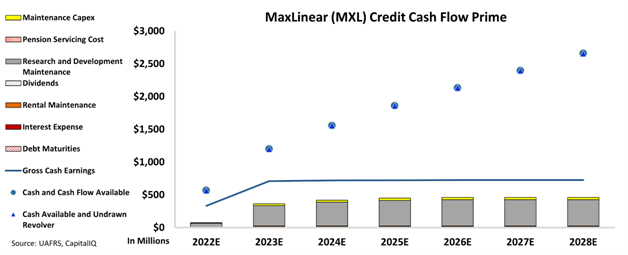As the semiconductor industry faces an oversupply, MaxLinear (MXL), a provider of essential products and services for people to connect through faster and smarter networks, appears to be negatively affected by this headwind. Moreso, credit rating agencies gave MXL a high-yield rating. In today’s FA Alpha, we’ll take a deeper look into MXL’s credit cash flow prime to assess its real credit risk.
FA Alpha Daily:
Wednesday Credit
Powered by Valens Research
Last year, semiconductor shortages dominated the headlines.
Driven by soaring demand during the pandemic, semiconductor companies enjoyed massive orders and recorded historical highs in revenues and profit.
Contrarily, the industry right now is facing the exact opposite of the challenge it has dealt with for the last few years, an oversupply.
One of the companies that can be affected by this new challenge is MaxLinear (MXL).
The company provides radiofrequency (“RF”) and systems-on-chip solutions (SoCs) for the connected home, wired and wireless infrastructure, and industrial and multi-market applications worldwide.
Its products and solutions are essential for next-generation connectivity technologies such as 5G and the Internet of Things (IoT). The company enables robust and reliable communication all around the world.
However, because of the recent discussions on oversupply in the semiconductor industry, the company’s stock has dropped from a high of $78 in late 2021 to $33, a 58% drop.
Also, it looks like the expected downturn in the semiconductor industry had a much bigger impact on credit rating agencies’ decisions rather than the company’s current strong positioning.
S&P currently gives MaxLinear a BB rating and has put it on negative watch since May, meaning that the company is not investment grade and is in a classification that includes much riskier high-yield companies.
We can figure out if there is a real risk for this company by leveraging the Credit Cash Flow Prime (“CCFP”) to understand the company’s obligations matched against its cash and cash flows.
In the chart below, the stacked bars represent the firm’s obligations each year for the next five years. These obligations are then compared to the firm’s cash flow (blue line) as well as the cash on hand available at the beginning of each period (blue dots) and available cash and undrawn revolver (blue triangles).
The CCFP chart shows that MaxLinear’s cash flows are much more than enough to cover its operating and financial obligations going forward.

As the CCFP shows, cash flows are comfortably above the company’s obligations and have a lot of room to fall before they would be anywhere close to being in a concerning situation for debt holders.
While it makes sense for equity holders to be worried about excess cash flows and therefore bring down the valuation, the CCFP indicates that this is not a high-yield credit risk with a 1 in 10 chance of defaulting in the next 5 years.
Considering that the company does not have any significant debt maturities and has large amounts of cash on hand, an IG3+ rating from Valens is much more reasonable.
It is our goal to bring forward the real creditworthiness of companies, built on the back of better Uniform Accounting.
To see Credit Cash Flow Prime ratings for thousands of companies, click here to learn more about the various subscription options now available for the full Valens Database.
SUMMARY and MaxLinear Tearsheet
As the Uniform Accounting tearsheet for MaxLinear (MXL:USA) highlights, the Uniform P/E trades at 10.1x, which is below the global corporate average of 17.8x and its historical P/E of 17.2x.
Low P/Es require low EPS growth to sustain them. In the case of MaxLinear, the company has recently shown a 324% Uniform EPS growth.
Wall Street analysts provide stock and valuation recommendations that in general provide very poor guidance or insight. However, Wall Street analysts’ near-term earnings forecasts tend to have relevant information.
We take Wall Street forecasts for GAAP earnings and convert them to Uniform earnings forecasts. When we do this, MaxLinear’s Wall Street analyst-driven forecast is for a 37% and -21% EPS growth in 2022 and 2023, respectively.
Based on the current stock market valuations, we can use earnings growth valuation metrics to back into the required growth rate to justify MaxLinear’s $31 stock price. These are often referred to as market embedded expectations.
Furthermore, the company’s earning power in 2021 is 5x the long-run corporate average. Moreover, cash flows and cash on hand are more than 2x its total obligations—including debt maturities and capex maintenance. The company also has an intrinsic credit risk that is 270bps above the risk-free rate.
Overall, this signals a moderate credit risk.
Lastly, MaxLinear’s Uniform earnings growth is above its peer averages and is trading below its average peer valuations.
Best regards,
Joel Litman & Rob Spivey
Chief Investment Strategist &
Director of Research
at Valens Research
This analysis of MaxLinear (MXL) credit outlook is the same type of analysis that powers our macro research detailed in the member-exclusive FA Alpha Pulse.
